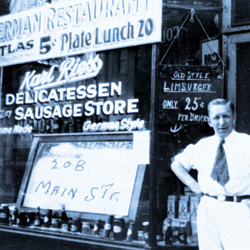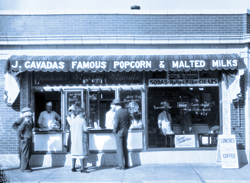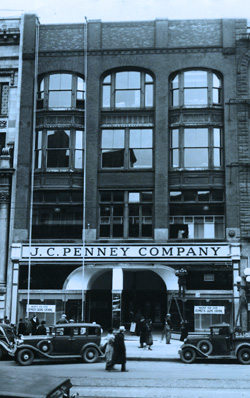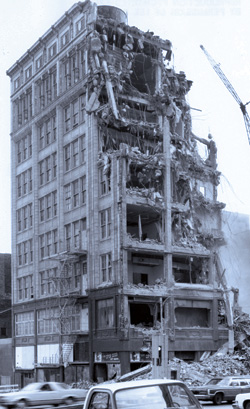Peoria’s downtown was the local “go-to” shopping destination for more than a century.
Like many great cities in America, Peoria was built alongside a river, and by necessity, the center of commerce clustered near transportation lines, including the navigable Illinois River. By the 1830s, as Jerry Klein reported in his 1985 book Peoria, the city had “twenty-five stores, two wholesale and five retail groceries, two drugstores, two hotels and several boarding houses” to serve its expanding population.
For more than a century, the type and number of retail establishments would change dramatically, but the center of downtown remained the “go-to destination” for a day of shopping, dining and entertainment. Eventually, as with many other river cities, Peoria’s downtown businesses gradually declined as the population shifted beyond the center of the city. In the beginning, however, there was a store for every need.
Les Magasins de Spécialités: The Specialty Stores
In the early years, specialty stores enabled proprietors to carve out a niche and focus on developing a loyal clientele. Downtown Peoria once boasted a wide variety of these types of stores, including the following listed in Roots’ 1856 Peoria City Directory:
- three booksellers/stationers;
- 28 boot and shoe manufacturers and dealers;
- seven carriage and wagon manufacturers;
- five confectioners;
- three crockery dealers;
- 51 grocers (Boy, did we like to eat!);
- three hat/cap manufacturers and dealers;
- 18 milliners and dress makers (all of which listed female proprietors);
- 23 tailors and clothing stores (many catering primarily to male clientele); and
- nine lumber merchants listed on Water Street alone!
Another interesting specialty store, Justus B. Fleck’s Segar and Tobacco Store, located at 13 Main, had competition from six other tobacco and cigar dealers in 1856. His advertisement indicated a stock of “Choice Segars, Wholesale and Retail Dealer in all kinds of Plug & Cut Chewing and Smoking Tobacco, Superior Maccaboy, French Rappee, and Scotch Snuff, Every Variety of Pipes, &C., & C.” Mr. Fleck, a Mason of German descent, also established a business on Water Street in 1852 and used its second-floor hall for “dramatic and operatic performances,” making it one of the earliest—if not the first—theaters in Peoria, according to the Historical Encyclopedia of Illinois, Vol. II. One can only presume that the men attending his theatre enjoyed a fine “segar” during the intermission!
Although there were many niche stores in early Peoria, the general stores—or dry goods stores, as they were known—were also very popular.

Les Magasins de Nouveautés: The Dry Goods Stores
Gradually, the specialty stores were replaced by les magasins de nouveautés, or dry goods stores, including ones owned by H.J. Herzberg, Moses Pettengill and W.S. Gregg. The 1856 city directory, for example, listed 24 dry goods merchants, including the store owned by Moses Pettengill at 31 Main St.
According to Charles Ballance’s The History of Peoria, Illinois, Pettengill was one of the “pioneer merchants” of Peoria, along with names like Amos P. Bartlett, P.C. Bartlett and John G. Bryson. He is also remembered as a leader in the anti-slavery movement; one of his early homes, located downtown at Liberty and Jefferson, served as a station on the Underground Railroad.
Another early advertisement, found in the 1856 city directory for W. S. Gregg, offeredthe following description: “Wholesale and Retail Dealer in Staple & Fancy Dry Goods, Ready-Made Clothing!!  Yankee Notions, Trimmings, Boots, Shoes, Hats,Caps,Carpetng (sic.), Floor Oil Cloths, Chinese Mattings, Carpet Bags, Umbrellas, Parasols, &C., &C.” As this ad makes clear, these dry goods stores emphasized “ready-to-wear”—what we would today call “off-the-rack”—clothing and products, which increased in popularity, particularly with female shoppers, as the domestic sphere expanded beyond the home in the latter part of the 19th century and more women found themselves busily engaged in a realm of activities and work outside the home.
Yankee Notions, Trimmings, Boots, Shoes, Hats,Caps,Carpetng (sic.), Floor Oil Cloths, Chinese Mattings, Carpet Bags, Umbrellas, Parasols, &C., &C.” As this ad makes clear, these dry goods stores emphasized “ready-to-wear”—what we would today call “off-the-rack”—clothing and products, which increased in popularity, particularly with female shoppers, as the domestic sphere expanded beyond the home in the latter part of the 19th century and more women found themselves busily engaged in a realm of activities and work outside the home.
In addition to dry goods stores, seven “Yankee notions and variety stores” were listed in a separate category of business in the directory. The term “Yankee notions” typically referred to a shop in which an assortment of small items, or sundries, were sold. It originated with the New England peddlers who sold such items from pushcarts or wagons. In fact, Samuel Lidwinosky, a Polish Jew who emigrated from Poland to Peoria in 1869, earned his way by peddling notions in Peoria and its adjoining counties for several years. According to History of Peoria County, Illinois, by 1874, the prosperous merchant had opened a dry goods store at 535 S. Adams St. and had stock value of $5,000 by 1880.
Dry goods stores could be distinguished from the typical grocery store, many of which were located right downtown, including the Zerwekh Grocery store at 615 Starr Street and the A&P Store on North Monroe. In addition to general grocers, Peoria—with its long history of livestock production—has had many outstanding specialty meat shops, including J.E. Gerber Meat Market at Third and Spencer.
With an abundance of freshly processed meat, there was never a problem finding lunch downtown, and shoppers could choose from an assortment of soda fountains, sandwich shops and restaurants. You could get a five-cent hot dog at Hunter’s on Perry and finish off the meal with their gourmet popcorn. Another popular spot, located at the corner of Jefferson and Hamilton , J. Cavadas Famous Popcorn & Malted Milks offered a special spring chicken sandwich for 45 cents or a pork tenderloin sandwich—a Peoria favorite—for just 10 cents. For the downtown business crowd, there was The Jumbo Lunch, across from the old Peoria County Courthouse, or old-world German fare at Karl Riess German Restaurant, located at 208 Main Street.
As the population grew, the value of downtown real estate increased, as it did in other urban centers. Single-purpose, one-story shops began to disappear, replaced by skyscrapers, multi-story buildings, housing, and multi-purpose stores. These “grand cathedrals” were large enough to contain fancy restaurants and a multitude of other attractions on their many floors.
Les Grands Magasins: Department Stores and the Birth of La Cathédrale du Commerce Modern
In the industrial era following the Civil War, the modern city gave birth to the department store on both sides of the Atlantic. As Gunther Barth describes in City People: The Rise of Modern City Culture in Nineteenth-Century America, “both the rate and nature of economic growth and the conditions and expectations of urban life influenced the transformation of dry goods stores selling fabrics into stores offering ready-to-wear clothes and a large variety of other goods conveniently arranged in various departments.”
 Downtown, the dry goods stores were replaced by department stores, or les grands magasins, like A.T. Stewart’s Marble Palace in New York City and Le Bon Marché in Paris. A rebuilt Bon Marché, which opened in 1880, set the standard for department stores around the world: “…its facades, elaborate as well as monumental, radiated the luxury and solidity that befitted a store selling distinction and respectability. Its corner rotunda drew people in toward the magic of the large windows grouped between the entrance portals leading into lavishly decorated grand halls that trumpeted the greatness of the store through the dramatic use of space.”
Downtown, the dry goods stores were replaced by department stores, or les grands magasins, like A.T. Stewart’s Marble Palace in New York City and Le Bon Marché in Paris. A rebuilt Bon Marché, which opened in 1880, set the standard for department stores around the world: “…its facades, elaborate as well as monumental, radiated the luxury and solidity that befitted a store selling distinction and respectability. Its corner rotunda drew people in toward the magic of the large windows grouped between the entrance portals leading into lavishly decorated grand halls that trumpeted the greatness of the store through the dramatic use of space.”
In London, William Whitley expanded the concept of “everything under one roof” to include a restaurant, real estate agency, cleaning and dyeing establishment, restrooms—a novelty at the time—reading room, hairdresser’s salon, telegraph bureau, post office and funeral parlor. According to an 1876 issue of the New York Daily Graphic, Whitley was the “universal provider,” taking care of his customers from “cradle to the grave.” The department store catered to the busy lifestyles of modern city dwellers, indeed bringing everything together under one roof, which made shopping more convenient and pleasurable. According to Peoria Memories: The Early Years, “As commerce grew and evolved, the services and products began to amalgamate. Instead of shoes in one store, dresses in another, hats and gloves in a third, you could get them all at a department store.”
“Organized into departments, they brought order to the jumble of the general store, relied on marked and fixed prices, allowed customers to look around freely, and reimbursed them or exchanged their purchases if they were not satisfied,” Barth wrote. “Their proprietors learned to buy in bulk from manufacturers on discount and to rely on high turnover, special sales, and constant advertising to compensate for their low prices. Their business flourished.”
 Shopping “Down-towny” and the Urban Retail Experience
Shopping “Down-towny” and the Urban Retail Experience
By the turn of the century, Peoria had a thriving retail culture, with choices galore for the urban shopper. Department stores prospered with the founding of the P.A. Bergner Store (1889), Schipper & Block (1860 in Pekin and 1879 in Peoria; later Block & Kuhl Co. in 1914) and Sears Roebuck and Co., which served as anchors for the downtown area. Peter A. Bergner borrowed $5,000 to open his store with success in 1889, although according to a 1989 Chicago Tribune article, it “played second fiddle to the Block & Kuhl’s stores, in much the way that Carson’s has been matched against Marshall Field & Co. in Chicago.”
As Henry James wrote in his autobiography, A Small Boy and Others, these stores “added a new charm to the modern city by opening the city center to the civilizing influences of women and visitors from out of town, making urban life, ‘so much more down-towny.’” Though they competed for market share, the competition was great for shoppers who were drawn downtown by good prices, a wide array of products, and a variety of activities, such as the annual Christmas parade. As Randle and Rudd noted, “The main competition in the market was Block & Kuhl’s, but there was also Montgomery Ward & Co., J.C. Penney and local stores like Klein’s, Clark’s and Schradski’s,” the latter of which operated for 132 years. Over time, Bergner’s dominated the pack, according to Mary M. Oakley, creative director at Burdon & Oakley Advertising of Peoria, which handled the store’s advertising for more than two decades.
Modern advertising created a demand for products that weren’t necessarily needed, but were certainly wanted, by members of a consumer-conscious culture, who increasingly, weren’t opposed to living beyond their means. “Buying on credit was not a common practice among these people who were just learning to buy things they did not need, but had not yet discovered that they could do so with money they did not have,” Barth wrote. The department store credit card, then, became a symbol of status, even though it increased consumer debt in a country long accustomed to a “pay-as-you-go” system of commerce.
In Peoria, the 1950 expansion of the Block & Kuhl building was noted in The American Cloak and Suit Review, which featured the following excerpt: “A very important event that will occur the early part of August for the buying public of Peoria will be the opening of one more great structure as an annex to the Block & Kuhl Co. department store… That it will be a very beautiful and imposing structure is evident from the plans that have been drawn. One of the prominent features will be an arcade front, which alone will cost about $30,000. The installation of a gigantic ventilating system and five new elevators will be other features of the new annex.”
Visitors truly appreciated the grandeur of this store. According to Jane Gillespie, a young girl whose recollection of Christmas shopping there was shared with Journal Star readers in 2001, “…nothing compares to the magic two little girls felt back in the 1930s when they entered the ‘Big White Store.’ …After we had looked at every doll, dollhouse and every other toy we hoped for, we headed for the seventh-floor tearoom for lunch. Actually, we would have much preferred Kresge’s counter, but Mother and Aunt enjoyed the tea room.”
Gillespie continues, describing her lunch with intricate detail: “…it was the Little Red Hen Luncheon. I can see it now. It was a chicken patty in the shape of a hen, a dollop of mashed potatoes, a serving of peas and carrots and a little metal dish of ice cream. We did enjoy looking out the windows of Peoria. To us, it seemed we were up very high and could even see the river. Next, it was down to the mezzanine, where we sat in theater-type seats and watched all the shoppers on the main floor below… It is hard to imagine a store today as crowded as Block & Kuhl was during the holiday season.” She noted that Adams was so congested between Main and Fulton, it was difficult to even walk down the street.
Eventually, the crowds diminished and the growth and prosperity of downtown retail slowed, as the population spread beyond the city center. By the mid-20th century, expanding upon the concept of shopping under one roof, retail development followed the population to the suburbs, giving rise to strip malls and massive, indoor shopping malls—both of which had convenient, adjacent parking, the availability of food, and proximity to home.

The Suburbanization of Retail: 1960s to the Present
What factors accounted for the decline of downtown retail in Peoria and around the country? As Jerry Klein explains in Peoria, “The rise of suburban shopping malls, the new freeways, and the increasing mobility of the American family had dramatically affected the downtown area, and one by one the retail stores left. Clarkes’s and Peoria Dry Goods went out of business, Block and Kuhl was bought by Carson, Pirie, Scott and Company and moved into Northwoods Mall, as did J.C. Penney and Montgomery Ward. The old five-and-ten-cent stores vanished and were replaced by huge discount stores that arose in the growing area to the northwest. Gift shops and specialty stores followed, buildings emptied out, and the proud old downtown began to deteriorate.” When Northwoods Mall opened in the early ‘70s, “Downtown Peoria moved to Sterling and War Memorial,” reported Mile Kenny in a 2008 issue of Senior Citizens News & Views.
Revitalization efforts to address the decline of downtown retail included the creation of a pedestrian mall, Fulton Plaza, in 1979. It was intended to connect to a new downtown mall, but those plans never came to fruition. Nevertheless, over the last several decades, civic leaders have continued the revitalization of downtown Peoria with the development of office space; construction of the Civic Center and the Twin Towers; development of the Riverfront and renovation of the Warehouse District; the creation of unique residential space; and, most recently, the razing of the Sears Block to make way for the new Peoria Riverfront Museum, a community-wide, collaborative effort to bring people back downtown. Ultimately, if the city continues to pursue this vision, the shoppers will return as well. iBi


